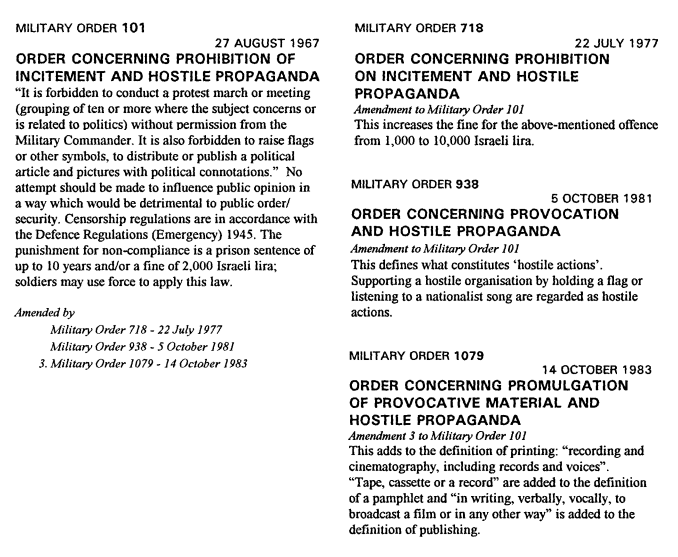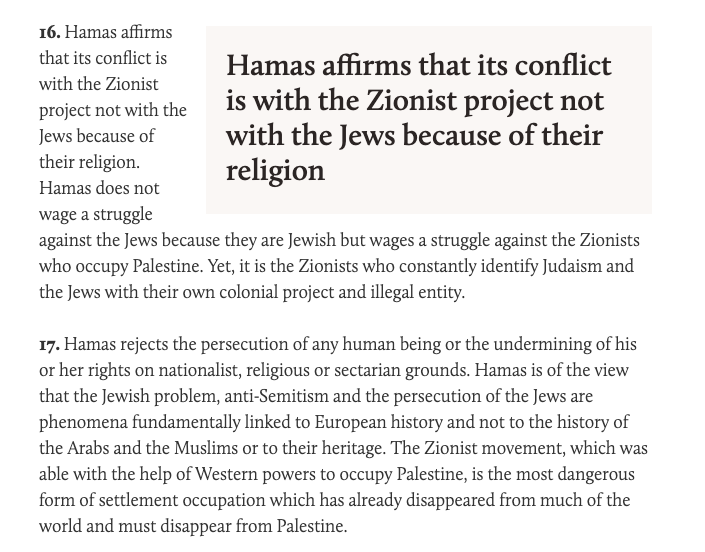After HAMAS took form during the first Palestinian Intifada (1987-1992), it released a 1988 charter. Formed out of the Muslim Brotherhood, an Egyptian organization, it had a lot of characteristics of old school Islamic movements, including performative references to the killing of Jews:
The Day of Judgment will not come about until Moslems fight Jews and kill them. Then, the Jews will hide behind rocks and trees, and the rocks and trees will cry out: ‘O Moslem, there is a Jew hiding behind me, come and kill him.”
Article 7, 1988 HAMAS Charter
It would be good to remember that this charter was launched during the First Intifada, which largely consisted of children throwing stones at Israeli soldiers who shot them dead, and in the context of massive human rights violations committed by Israel against every point of Palestinian life.
Universities, colleges, schools, and even kindergartens were closed by Israeli Military Orders for “security reasons” for years on end. Raids of lecturers and teachers homes for continuing to teach outside of the closed campuses. Arrests of children carrying school books for defying the military orders targeting Palestinian education. Homes were demolished routinely. Agricultural crops destroyed routinely. People were shot routinely. People were arrested routinely. Some of the repression reflected Orwellian levels of pettiness.
The Jerusalem Media and Communications Center (JMCC) published a reference book, Israeli Military Orders in the Occupied Palestinian West Bank, 1967-1992, which reveals the extent of Israel’s granular matrix of control. The repression was present at all conceivable levels of life. One Israeli military order, amended three times to extend its reach, was used to arrest of anyone wearing the four colors of the Palestinian flag:

It would be fair to say that the experience of Palestinians, at the point in their history when the 1988 HAMAS Charter was born, was an experience of an endless river of daily reports of the latest Israeli atrocities against an unarmed population, and news of the latest repressive measures leveled against all aspects of Palestinian daily life.
You can easily find the 1988 HAMAS charter on the website of the Israeli Ministry of Foreign Affairs and on Israeli embassy websites around the world. This 1988 charter is the only HAMAS charter you will hear about from Israeli sources.
What you won’t find is the updated 2017 HAMAS charter, which replaced the 1988 HAMAS charter. This current charter is either never mentioned or is dismissed as not relevant—strangely by the same people who thought the 1988 HAMAS charter was relevant enough to disseminate, as proof of its enemy’s genocidal nature. This makes no sense.
The reason for Israel’s very intentional avoidance of any promotion of the 2017 HAMAS charter is the inconvenient clarity that nineteen years of HAMAS’s experience as a political organization brought to the new version. Previous references to Jews as a whole were replaced by chapters that confined HAMAS’s goals as opposition not to Jews, but to Zionism—the political philosophy that gave birth to the nation state of Israel:

Interestingly, the 2017 HAMAS Charter takes note of Israel’s intentional conflation of it as an international entity with world Jewry, a tactic that has resulted in a variety of explicit laws and a climate of fear that criticism of Israel is “antisemetic”.
As there are plenty of anti-Zionist Jews in the world who do not agree with Israel’s acts towards Palestinians, a fair case can be made that Israel’s intentional muddying of the waters—for the purpose of deflecting criticism of Israel by casting this criticism as a hatred of Jews—has harmed Jews everywhere by tarring their names with a human rights-violating, political entity that the majority of Jews on earth have never even visited.
HAMAS is not out to ‘kill all Jews’. Its conflict, according to its 2017 charter, is solely with the State of Israel, a country born through the destruction and depopulation of 415 Palestinian villages, which turned 800,000 Palestinians into stateless refugees, forever barred from returning to their ancestral homelands.
Scottish OG from the time of the First Palestinian Intifada and the birth of the international movement of solidarity with the Palestinian people • Author of one of the first blogs/first warblog— A Personal Diary of the Israeli-Palestinian Conflict (1994-1998) • Former Friends of Birzeit University (FoBZU) Coordinator • Former Birzeit University Public Relations Officer and Webmaster • Co-creator of the first independent media website in 1996— On the Ground In Ramallah: Reports from a town become battlefield • Cofounder and Editor of the original Electronic Intifada website • Day producer for Global Revolution’s news channel during #OccupyWallStreet, which introduced the world to the crowd-sourced power of livestreaming • Creator of countless websites for pro-Palestinian and nonprofit organizations around the world via nigelparry.net


